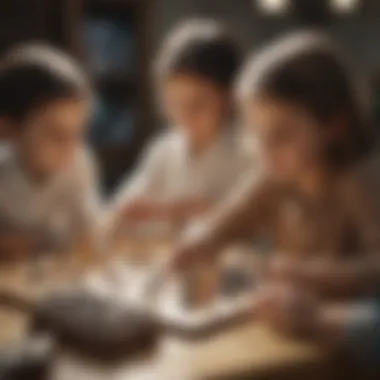Understanding the Montessori Method of Teaching


Intro
The Montessori method of teaching stands as a notable shift in the realm of education. Developed by Dr. Maria Montessori, this approach has gained recognition for its child-centered learning philosophy. In contemporary educational discourse, it is essential to explore not only its foundational principles but also its recent advancements and adaptability in various contexts.
The fundamental idea behind the Montessori method is simple yet profound: children learn best when they are engaged in activities that interest them. This pedagogical approach fosters an environment where students take the initiative in their learning journey. Educators play a supportive role, guiding rather than directing.
This article delves into the deeper aspects of the Montessori method. By examining recent advances, including discoveries in educational psychology and technological innovations that support individualized learning, we can gain insights into its effectiveness.
Furthermore, understanding the methodology applied in recent studies provides clarity on how to assess its impact. The information presented throughout aims to illuminate the path for educators, researchers, and parents interested in alternative educational frameworks.
Prologue to the Montessori Method
The Montessori Method represents a distinctive approach to education, placing the learner at the center of the teaching process. Its significance lies in its advocacy for self-directed, experiential learning and its intent to adopt a holistic view of child development. This article will navigate through various aspects of the Montessori philosophy, emphasizing its potential to nurture independence and critical thinking in children. Understanding the foundations and implementation of this method facilitates a deeper appreciation of its benefits and the considerations necessary for its success in diverse educational settings.
Historical Context
The Montessori approach can be traced back to the early 20th century, pioneered by Dr. Maria Montessori, an Italian physician and educator. Her work began in 1907 with the establishment of the Casa dei Bambini, a school in a poor neighborhood of Rome. Observing the natural behavior of children, Montessori concluded that children learn best when they engage actively with their environment. This insight led her to develop a unique educational framework that emphasizes freedom, responsibility, and respect for a child's natural psychological, physical, and social development.
The method gained international recognition and expanded steadily. Schools adopting this approach began appearing worldwide, including in the United States, where the first Montessori school opened in 1911. The historical context provides insight into how educational landscapes evolved and how early influences shaped the formulation and adoption of Montessori principles in modern curricula.
Core Philosophy
Central to the Montessori Method is its core philosophy, which revolves around the understanding of child development. This philosophy asserts that education should provide a nurturing environment that fosters independence and self-discipline. The method is predicated on several key tenets:
- Respect for the child: Educators recognize that each child is unique and possesses intrinsic potential.
- Prepared environment: Classrooms are designed to facilitate independence, allowing children to choose activities that align with their interests and developmental levels.
- Education for life: The purpose of education, according to Montessori, goes beyond academic knowledge. It aims to cultivate a child's character, preparing them for the challenges of life.
"The environment must be rich in motives which lend interest to activity and invite the child to conduct his own experience." – Dr. Maria Montessori
Thus, the Montessori philosophy integrates various dimensions of education, including social, emotional, and cognitive aspects. This holistic approach sets the stage for a learning experience that goes beyond traditional methods, aiming to create a generation of independent thinkers who are equipped for lifelong learning.
Key Principles of the Montessori Method
Understanding the key principles of the Montessori method is essential for grasping how this educational system fosters independence and learning. Each of these principles contributes a fundamental aspect to creating an enriching environment for children. The method places great significance on tailoring education to individual needs, promoting social and emotional skills, and developing a love for learning that endures throughout life.
Child-Centered Learning
Child-centered learning lies at the heart of the Montessori philosophy. Unlike traditional education systems, which often prioritize standardized curriculum delivery, this approach allows children to take charge of their own educational journey. Educators in Montessori settings recognize that every child is unique, with distinct interests and learning speeds. As such, the role of the teacher becomes one of a facilitator rather than a director.
By allowing children to choose activities that intrigue them, they become engaged and motivated learners. This autonomy encourages critical thinking and problem-solving skills, helping to engender a sense of agency. Parents and educators often notice that children develop a deeper understanding of concepts when they explore subjects on their own.
Prepared Environment
A prepared environment is vital for effective Montessori education. The learning space is thoughtfully designed to be inviting and accessible, stimulating curiosity while supporting independence. The materials and activities are organized in a way that allows children to explore freely and safely. Each item within the environment has a specific purpose, and students are encouraged to interact with these resources at will.
Essential elements of a prepared environment include:
- Accessibility: All materials are within reach, promoting self-sufficiency.
- Order: A systematic arrangement aids children in making choices and developing responsibility.
- Beauty: An aesthetically pleasing space enhances motivation and emotional well-being.
A well-prepared environment not only supports learning but also fosters respect for the materials and the surroundings. Children learn to appreciate the value of their environment, becoming responsible stewards of both the materials and their community.
Individual Pace of Learning
The principle of individual pace of learning is crucial in the Montessori method. Each child progresses at their own speed, allowing them to master concepts before moving forward. This flexibility in timelines reduces pressure, leading to a more profound understanding of the subject matter. When children are not rushed, they can fully engage with activities and reflect on their learning.
Moreover, this approach helps to cultivate self-confidence. Children are encouraged to celebrate their achievements, whether big or small, which reinforces their intrinsic motivation. There are marked differences in learning capabilities among children. By respecting these differences, the Montessori method supports a more natural and comprehensive learning process.
"In a Montessori environment, the education provided is tailored to the individual child rather than a one-size-fits-all approach."
Educational Materials in Montessori Classrooms
In Montessori classrooms, educational materials play a pivotal role. They are not merely tools for teaching; they are integral to the philosophy of the Montessori method. These materials facilitate self-directed learning and exploration. They are designed to help children engage actively with concepts rather than passively receiving information. The right materials can enhance understanding, encourage curiosity, and inspire a love of learning.
The idea behind manipulative materials is that learners can physically interact with objects to understand abstract concepts. This hands-on experience is likely to make learning more memorable. For example, children may use blocks or beads to grasp basic mathematical operations like addition and subtraction. By manipulating these objects, they translate numerical ideas into tangible experiences.
"Giving children the opportunity to explore with hands-on materials lays the foundation for critical thinking and problem-solving skills."
Role of Manipulative Materials
Manipulative materials are fundamental in Montessori education. They allow for sensory exploration and cognitive development. When children touch, move, and experiment with these materials, they engage multiple senses. This multisensory approach reinforces learning. It appeals to diverse learning styles as well.
Benefits of manipulative materials include:
- Encouraging independence: Children learn to manage their learning environment and take ownership of their educational experience.
- Fostering concentration: Engaging with manipulatives helps sustain attention and can lead to deeper understanding.
- Promoting social interaction: Working with others on manipulative tasks encourages communication and collaboration.
In addition, these materials are often self-correcting, allowing students to recognize and fix their mistakes independently. This feature encourages self-assessment and enhances problem-solving skills.


Types of Montessori Materials
The diversity of materials in a Montessori classroom caters to a wide range of developmental areas. They are carefully crafted to meet specific educational goals. Examples of key types of Montessori materials include:
- Sensorial materials: These help children refine their senses. For instance, the Pink Tower and Brown Stairs develop visual discrimination and spatial awareness.
- Practical life materials: Activities like pouring, sweeping, and buttoning foster motor skills and independence. They also teach children about daily life tasks.
- Language materials: Tools like letter tiles and sandpaper letters support literacy and phonetic awareness.
- Mathematics materials: Items such as golden beads for decimal systems assist in understanding mathematical concepts effectively.
- Cultural materials: These introduce children to geography, science, and history through hands-on experiences.
Each material serves not only an educational purpose but also aligns with the child's intrinsic desire to learn and explore.
In summary, educational materials in Montessori classrooms form a fundamental aspect of the learning process. They empower children to engage actively with their environment. This leads to a holistic understanding of the world around them.
Teacher's Role in Montessori Education
In Montessori education, the teacher's role is fundamentally different from that in traditional schools. The focus shifts from direct instruction to a supportive and observant presence. This change is crucial in fostering an effective learning environment where students take charge of their educational journey. Educators are not merely dispensers of knowledge; their primary function is to facilitate exploration, promote independence, and nurture the innate curiosity of each child.
Guiding Rather than Instructing
The Montessori approach elevates teacher guidance above standard instruction. Educators guide students through their learning experiences by setting the stage for self-discovery. This gentle direction allows children to explore subjects deeply while developing critical thinking skills. Instead of a one-size-fits-all lecture style, the teacher identifies the interests of individual students.
The following are the key aspects of this guiding role:
- Creating a supportive atmosphere: Teachers cultivate an emotional environment where students feel safe to express themselves.
- Encouraging autonomy: Students develop independence as they choose their activities and work at their own pace.
- Asking open-ended questions: These questions promote thought and help develop problem-solving skills.
By stepping back, educators allow children to lead their learning, resulting in a deeper and lasting understanding of concepts.
Observation and Assessment
Observation is a cornerstone of Montessori education. Teachers are trained to carefully observe each child's interactions and progress. This observational role is not passive; it informs the teacher’s understanding of individual learning styles and needs. The analysis allows the educator to tailor activities that challenge students adequately and engage their interests.
Key points regarding observation and assessment include:
- Individualized learning plans: Teachers adjust learning experiences based on insights gathered from observations.
- Tracking progress: Continuous assessment is not about grades, but rather about understanding each child's personal growth.
- Feedback for improvement: Teachers provide constructive feedback that encourages positive development.
"In Montessori education, assessment is an ongoing process aimed at fostering development, not merely measuring it."
In summary, the teacher’s dual role as a guide and observer is essential in the Montessori classroom. This approach enables learners to become active participants in their education, fostering a lifelong love for learning.
Montessori Method Across Age Groups
Understanding how the Montessori method applies across various age groups is crucial for educators and parents. The Montessori approach is not a one-size-fits-all, but rather a tailored framework that adapts to the developmental needs of each child. This adaptability supports the child's natural growth and fosters independence at every stage.
Infants and Toddlers
In the context of infants and toddlers, the Montessori method focuses heavily on sensory experiences and movement. Environments are designed to be safe yet stimulating, allowing young children to explore and engage with their surroundings. The use of natural materials is emphasized, promoting sensory development and encouraging curiosity.
Parents can create Montessori-inspired spaces at home. Simple actions, like offering varied textures for tactile exploration, can make a significant impact. Infant and toddler engagement helps build a foundation of trust and security. The emphasis on freedom within limits helps kids to feel secure while they learn to navigate their environment.
Preschool and Kindergarten
During preschool and kindergarten years, the Montessori method shifts towards more structured activities while still encouraging child-led exploration. This age group benefits from a balance between independence and guidance. Children are encouraged to choose their activities from a prepared environment while learning essential skills.
Activities may include practical life skills, like cooking or cleaning, alongside academic subjects. The importance of social interaction increases, as children learn to work collaboratively. Teachers serve as facilitators, guiding students rather than directing them. This creates an atmosphere where children feel empowered to take charge of their learning.
Elementary and Beyond
As children enter elementary education, the Montessori method supports deeper engagement with complex concepts. Here, the focus is on critical thinking and problem-solving through hands-on learning materials and group projects. The curriculum is designed to promote intrinsic motivation, allowing students to pursue individual interests within a broader academic framework.
Field trips, experiments, and creative projects are common in this stage, reinforcing the interdisciplinary nature of the learning experience. The method encourages students to ask questions and explore answers through research. This phase also emphasizes the importance of community engagement, preparing students for active participation beyond the classroom.
"The Montessori method shows that education can foster not just academic achievement, but also a profound sense of independence and responsibility in young people."
End
Overall, the Montessori method's adaptability across age groups helps cater to the evolving needs of children. Each phase of development benefits from principles that encourage learning through exploration and social interaction. Understanding these stages is essential for implementing effective Montessori practices, paving the way for children to thrive academically and personally.
Benefits of the Montessori Method
The Montessori method's emphasis on individualized, child-led learning has profound implications for social, emotional, and cognitive development. This section highlights how these benefits manifest in educational settings, fostering overall growth in students. Understanding the significance of these benefits provides insight into why many educators and parents choose this approach over traditional methods.
Social Development
One of the core advantages of the Montessori method lies in its promotion of social skills among children. In a Montessori classroom, students of different ages work together, thereby cultivating a sense of community. This setting encourages peer learning and collaboration. As children interact, they learn to communicate effectively, resolve conflicts, and develop empathy.
Moreover, the mixed-age environment allows younger children to learn from their older peers, while older students reinforce their knowledge by teaching concepts. This reciprocal relationship encourages a sense of responsibility and highlights varied perspectives in problem-solving.
Emotional Resilience
Another notable benefit of the Montessori method is the enhancement of emotional resilience. The approach empowers children to make choices regarding their learning, fostering independence. When learners make decisions about activities, they experience a sense of ownership over their education. This autonomy nurtures self-confidence and initiative.


Additionally, the Montessori method incorporates an understanding of emotional development. Teachers observe children's emotional reactions and provide support during challenges. By teaching children to recognize and regulate their emotions, they build essential coping mechanisms for future adversities.
"Through freedom, we gain confidence, and through confidence we can explore new horizons."
Cognitive Gains
Cognitive development in the Montessori method is tied closely to its hands-on learning materials. The design of these materials engages children in exploring concepts at their own pace, leading to deeper understanding. Students can manipulate objects, experiment, and practice problem-solving skills without the pressure found in traditional settings.
Research shows that children exposed to the Montessori method often outperform peers in standardized testing, particularly in areas like mathematics and reading. The method nurtures critical thinking skills, as children learn to challenge assumptions and seek solutions independently.
Challenges in Implementing Montessori Practices
The Montessori method is often seen as a breath of fresh air in education. However, implementing its practices can be challenging. Understanding these challenges is crucial for educators intending to adopt this educational framework. Such challenges not only affect the effectiveness of primary educational outcomes but also shape the overall ethos of a learning environment.
Misunderstandings of the Method
Misconceptions about the Montessori method can hamper its successful application. One prevalent misunderstanding is that Montessori is merely about letting children do whatever they want without guidance. In truth, the method is intricately designed to provide structured freedom, where children explore within parameters set by educators. This balance is essential for fostering independence while ensuring children remain focused on learning objectives.
Moreover, some argue that children are too young to learn independently, but plenty of research supports the effectiveness of child-led learning at a young age. When educators equate Montessori with a lack of discipline, they miss the point. Montessori practitioners guide children with a curated set of learning materials that cater to individual interests and developmental stages. This guided choice is a key component that gives learners a sense of ownership over their education, rather than chaos.
Adaptation in Traditional Settings
In traditional educational systems, the transition to a Montessori-inspired approach can appear daunting. Classes organized by age are common in conventional settings. In contrast, Montessori favors mixed-age classrooms, encouraging peer learning and mentorship. Integrating mixed-age cohorts can be a difficult change, but it is fundamental to achieving a genuine Montessori experience.
Additionally, many teachers in traditional systems are trained to deliver standard curricula, rather than facilitate individualized learning paths. This skill gap can lead to resistance in adopting Montessori principles effectively. Proper training and ongoing support for educators are vital to align teaching methods with Montessori philosophy.
Schools often express concern about meeting standardized testing requirements under a Montessori framework. Critics argue that without structured lessons, students may fall behind in core academic skills. However, studies indicate that Montessori students often excel in standardized tests due to the strong foundational knowledge gained from hands-on learning.
Factors such as misunderstandings of the method and adaptation in traditional educational settings need careful consideration. With targeted training and a clear understanding of Montessori principles, these obstacles can be overcome. This adaptability ensures that educators can foster environments where children thrive, maintain their intrinsic curiosity, and develop critical skills.
Montessori and Modern Educational Trends
The Montessori method of teaching has increasingly gained a foothold in contemporary educational discussions. This evolution arises partly due to the growing recognition of individualized learning approaches. In a world that continuously shifts in technology and methodologies, understanding how the Montessori framework aligns or contrasts with modern educational trends is essential for educators and parents alike.
Integration with Technology
Integrating technology within Montessori education is an area of rich discussion. Traditionalists often argue that tech detracts from hands-on, experiential learning emphasized by Montessori. However, when used thoughtfully, technology can enhance the learning experience. For instance, educational software and interactive apps can supplement traditional materials. This fusion can facilitate personalized learning, allowing children to engage with topics at their own pace.
The balance lies in ensuring technology enhances rather than replaces core Montessori principles. Here are some points to consider about this integration:
- Supplementary Tool: Use technology as an additional resource. It can complement, not substitute, physical manipulative materials that Montessori values.
- Focus On Collaboration: Encourage students to collaborate on projects using digital tools to foster communication skills. This approach aligns well with the Montessori emphasis on interpersonal interactions.
- Critical Thinking: Exposure to technology presented in a Montessori setting can encourage critical thinking. When students choose software that interests them, they invest in their learning.
Project-Based Learning
Project-based learning is another modern trend that fits well with the Montessori philosophy. Both methodologies prioritize active engagement and allow for deep exploration of subjects. Project-based learning encourages students to investigate real-world problems, fostering critical thinking and problem-solving skills. Here are essential aspects of this approach:
- Ownership of Learning: Students in project-based learning take charge of their educational journey. This autonomy is a key tenet of the Montessori method, promoting a sense of responsibility.
- Interdisciplinary Connections: Projects often allow for connections among various subjects, enhancing the learning experience. This holistic approach mirrors the Montessori educational experience, where children learn subjects in tandem rather than isolation.
- Flexible Learning Environments: Both strategies benefit from flexible classroom setups, where space is designed to accommodate different projects and collaborative efforts.
"The future of education must embrace change, blending established methodologies like Montessori with innovative practices such as project-based learning."
Integrating these modern trends within the Montessori framework has the potential to improve educational outcomes. With thoughtful application, the strengths of both can create more engaging and effective learning environments for children.
Parental Involvement in Montessori Education
Parental involvement is a critical component of Montessori education. It plays a central role in supporting the child-led learning approach that defines the Montessori method. When parents engage in their child's educational journey, it fosters a collaborative environment that benefits both home and school experiences. This engagement not only enriches the child's learning but also aligns with the philosophy of independence and self-directed exploration that the Montessori method advocates.
Benefits of Parental Involvement
Having parents actively involved can lead to several significant advantages:
- Stronger connection to learning: When parents participate, children often feel more valued and understood. This connection makes children more motivated to engage fully with their learning.
- Reinforcement of concepts: Parents can help reinforce what children learn in school through practical experiences at home. Activities may include reading together, exploring nature, or creating projects which align with classroom teachings.
- Facilitation of independence: With guidance from parents, children can practice decision-making and critical thinking skills in a safe environment. Tasks given at home further enhance their ability to work independently in school.
- Development of social skills: Parents can arrange playdates or group activities that allow children to develop social skills, an essential aspect of the Montessori philosophy.
Supporting Learning at Home
Parents can support their child's Montessori education through various strategies. One effective way is by creating a prepared environment at home—a space where children can explore and learn independently. Here are some specific elements:
- Organized spaces: Designate areas for specific activities, like reading, art, or building. This organization helps children know where to find materials and encourages them to take initiative in their learning.
- Accessible materials: Ensure that educational materials are within the child's reach. This accessibility promotes curiosity and intrinsic motivation to learn as children can freely choose what to explore.
- Encourage self-discipline: Allow children to set their own learning goals. This practice helps them develop a sense of responsibility and increases their motivation towards achieving them.
It’s also important for parents to observe and engage with their child’s interests. Utilizing everyday moments for learning—like cooking or gardening—can immerse children in hands-on experiences that reflect the Montessori method.
Communication with Educators
Open communication between parents and educators is essential for fostering a productive learning environment. Parents should establish a partnership with teachers to support their child's educational growth. Here are some best practices:
- Regular updates: Keep in touch with educators through newsletters or digital communication platforms like Facebook or school portals. This ensures that parents are aware of curriculum, activities, and developmental milestones.
- Participate in meetings: Attend parent-teacher conferences or workshops. Engaging in these platforms allows parents to share insights about their child while learning more about the Montessori approach.
- Ask questions: Encourage discussions regarding the child's progress or areas of concern. This dialogue helps build understanding and strengthen the home-school connection.
- Share experiences: Communicate any relevant experiences or observations from home. This can provide teachers with a fuller picture of the child, allowing for more personalized education.
In summary, parental involvement in Montessori education enhances learning outcomes and fosters holistic development. By creating supportive home environments and maintaining open communication with educators, parents can play an invaluable role in their child's educational journey.
"Education is a natural process carried out by the child and is not acquired by listening to words but by experiences in the environment." - Maria Montessori


Through conscious engagement and collaboration, parents can ensure their children thrive in the Montessori framework.
Research on the Effectiveness of the Montessori Method
Understanding the effectiveness of the Montessori method is crucial to evaluate its impact on student learning and development. Researchers have been exploring this method for decades. They focus not only on academic achievement but also on social and emotional development. This comprehensive approach provides valuable insights into how Montessori education fosters skilled, independent learners.
Longitudinal Studies
Longitudinal studies in Montessori education look at students over many years to assess their development. These studies often compare Montessori students with those from traditional educational backgrounds. Results typically reveal positive outcomes. For instance, Montessori students generally show higher academic achievement in areas like mathematics and reading. They also exhibit better social skills, problem-solving abilities, and emotional intelligence.
One significant longitudinal study was conducted by Angeline Lillard and Elizabeth Else-Quest in 2006. Their findings supported the effectiveness of Montessori education in fostering not just academic success, but also creativity and social understanding. The research showed that children in Montessori programs scored higher in standardized tests, which suggests a strong foundation in core subjects.
Comparative Studies with Traditional Methods
Comparative studies focus on the differences between the Montessori method and traditional teaching methods. These studies help highlight the unique aspects of Montessori education. For instance, children in Montessori settings tend to learn at their own pace, allowing for deeper understanding of concepts compared to the more rigid structure of traditional classrooms.
Studies often indicate the following benefits:
- Higher levels of engagement: Montessori students frequently display greater interest and enthusiasm for learning.
- Enhanced critical thinking: Montessori programs encourage inquiry and exploration, leading to improved critical thinking skills.
- Greater independence: Students learn to make choices about their learning, which fosters a sense of responsibility.
In summary, the research underscores Montessori education as a viable alternative to traditional methods. This approach promotes not only academic success but also essential life skills. Parents and educators should consider these findings when choosing an educational path for children.
Global Perspectives on Montessori Education
The Montessori method of education is not limited to a single cultural or national context. Its adaptability to various environments is one of its notable strengths. The understanding of how this approach is embraced globally reveals insights into its principles and their application across diverse educational systems. This section delves into how different countries have adopted the Montessori philosophy, as well as the cultural adaptations that often accompany this adoption, showcasing the method's versatility and relevance in today’s world.
Adoption in Different Countries
Around the world, the Montessori method has seen widespread adoption in various educational systems, each tailoring the approach to meet local needs and values.
- United States: In the U.S., the Montessori method is featured prominently in private and charter schools. Many educators find its child-led learning principles particularly valuable for fostering independence among students. Traditional teaching methods are often perceived as less effective in comparison.
- Italy: In its country of origin, Italy, the Montessori method is deeply rooted in the national educational framework. Many public schools incorporate Montessori-based principles, emphasizing not only academia but also social and emotional development.
- India: In India, the Montessori method often focuses on early childhood education. Schools highlight experiential learning, integrating local context and culture into their curriculum to ensure relevance to students’ lives.
- Australia: Similar to the U.S., Australia has embraced Montessori in both urban and rural settings, promoting inclusivity and individual learning styles. The approach often aligns well with indigenous education principles, emphasizing connection to the environment.
The varying degrees of acceptance and adaptation indicate a broader recognition of the method's effectiveness in fostering holistic development in children. Each country’s approach respects local education norms while integrating Montessori principles, leading to a rich tapestry of educational practices.
Cultural Adaptations
Adapting the Montessori method to fit different cultural contexts can enhance its effectiveness. Each culture brings unique values and educational priorities that shape how Montessori principles are implemented.
- Local Curriculum Integration: Countries may incorporate local languages, history, or traditions within the Montessori framework. This ensures students engage deeply with their cultural identity while learning.
- Community Involvement: In many cultures, education extends beyond the classroom. Montessori schools may involve families and community members in learning processes. This engagement enriches the educational experience and strengthens the connection between home and school.
- Flexible Learning Environments: Cultural norms regarding space and interaction also play a significant role. For instance, some cultures prioritize outdoor learning as part of the Montessori method, while others may focus more on classroom-centric activities. Educators adapt to these norms, creating environments that foster exploration as per cultural expectations.
Future Trends in Montessori Education
The Montessori method of teaching is adapting to meet contemporary challenges and shifting paradigms in education. As society evolves, so does the understanding of how children learn best, making it imperative to examine the future trends shaping Montessori education. This article section delves into evolving educational needs and sustainability in education, which are critical in ensuring that Montessori principles remain relevant and impactful.
Evolving Educational Needs
The landscape of education is in a continuous state of flux, driven by technological advancements, changing societal expectations, and growing awareness of diverse learning styles. Montessori education is not insulated from these shifts. To remain effective, it must cater to an increasingly varied student population with unique needs.
Educators in Montessori settings are beginning to emphasize differentiated instruction. This approach acknowledges that children have differing abilities, backgrounds, and interests. The integration of technology is also becoming more pronounced. For instance, using tablets or interactive software can supplement traditional Montessori materials. This blending helps prepare children for a world where digital literacy is key.
Moreover, the focus on social-emotional learning has gained traction. Schools are recognizing the importance of emotional intelligence alongside academic success. Thus, the Montessori method's intrinsic respect for the child's pace and individuality aligns well with these emerging educational demands.
Additionally, as schools face pressure to meet standardized testing requirements, Montessori educators are exploring ways to marry these expectations with child-led learning, ensuring that the spirit of Montessori remains intact while showing academic progress. This balance is crucial as it addresses concerns from parents and policymakers alike, paving the way for a more harmonious educational environment.
Sustainability in Education
Sustainability is becoming a focal point in education, driven by concerns over climate change and the need for responsible stewardship of resources. Montessori education inherently supports sustainability through its principles that promote independence and respect for the environment. Montessori classrooms are often designed to be eco-friendly, utilizing natural materials and fostering a connection between students and nature.
In the future, we can expect more schools to incorporate sustainable practices within their curricula. This may include outdoor classrooms, gardening projects, and lessons focused on environmental stewardship. Learning through hands-on experience in nature aligns well with the Montessori philosophy of experiential learning.
Furthermore, schools are increasingly looking at their operational practices. There is a surge in initiatives aimed at minimizing waste and promoting recycling and conservation efforts within school environments. This aligns with the Montessori ethos and can be an effective tool for teaching children about the importance of sustainability.
"A true education is one that nurtures not just the mind but also the heart and environment."
End: Montessori Education's Lasting Impact
The Montessori method has a profound and lasting impact on education today. Its emphasis on child-led learning resonates in various educational frameworks. The Montessori method has helped shape numerous teaching philosophies and continues to influence the way education adapts to address students’ needs.
Summary of Key Insights
The main insights from this article illustrate the effectiveness and adaptability of the Montessori approach. Here are some notable points:
- Child-Centered Learning: Students are at the forefront of their educational journey. This promotes critical thinking and independence.
- Prepared Environment: Classrooms are thoughtfully arranged to promote exploration and self-directed learning.
- Teacher’s Role As Guide: Instructors do not merely transmit knowledge; they guide students to foster curiosity and exploration.
- Benefits Across Age Groups: From toddlers to older students, the Montessori method is designed to meet diverse developmental needs.
These factors contribute to a positive educational experience characterized by engagement and the pursuit of knowledge.
Continuing Relevance in Modern Education
In modern education, the relevance of the Montessori method remains significant. Its principles align closely with current educational trends that prioritize personalized learning and adaptability. Some ways in which the Montessori approach remains relevant include:
- Integration of Technology: Montessori education increasingly incorporates technology, aiding self-directed learning and expanding access to resources.
- Focus on Socio-Emotional Development: Modern education stresses the importance of emotional intelligence, which is a core component of the Montessori philosophy.
- Hybrid Learning Models: As schools adapt to new learning environments, the flexibility of the Montessori model assists in meeting varied learning preferences.
The Montessori method continues to inspire educators and parents in promoting a holistic educational experience.















